Bodie “Ghost Town”, Mono County, California, USA, September 2010
------------------------------------------------------------------------------------------------------------------------------
Back in 1859, prospector W.S. Bodie (either Wakeman, William or Waterman S Body, Bodey or Bodie, depending on which story you believe) headed from Lee Vining, California, USA into the surrounding hills in search of a little fame and fortune. Several miles north of Mono Lake he struck gold, triggering the rapid growth of the mining boom town which came to be called Bodie in his name, and what is now perhaps America’s best preserved ghost town.
http://maps.google.com/maps?ll=38.2...&lci=org.wikipedia.en&q=38.212222,-119.012222
Unfortunately for WS, he died in a severe snow storm that same winter and, although his fame was now guaranteed, he never lived to see the town which took his name, nor the fortune he sought - that fell to the mine company owners who followed him.
The ghosts of gold rush towns litter the USA, but as boom towns go Bodie’s story is pretty impressive, growing from WS and three companions to a town of around 10,000 residents by the mid 1870s. By 1882, the big gold strikes were done and the town was already shrinking fast as the gold started to run out.
Bodie is a remote and inhospitable place: it’s 13 miles east of Highway 395 on Highway 270 – the last three miles of which is still unpaved – and sits at 8,375 feet above sea level. As a result, it is HOT and very dry in the summer and although you don’t have to drive a 4x4, it certainly helps. In the winter, Bodie is often completely snowbound, with deep snow drifts and whiteouts driven by high winds. Bodie regularly appears on the list of the coldest place in the United States, with temperatures frequently below -18c and average January temps between of -15c to 4c. In the winter, if you don’t have skis, snowshoes or a snowmobile, you won’t be visiting.
Without the gold to keep them there, the miners went elsewhere, and as the miners left the people who supported their needs, including bankers, shopkeepers, inn keepers, laundrymen, hookers, teachers and stock workers (in no particular order) began to leave too. Local land owners charged those leaving a fee for crossing their land and their rivers, per person and per pound. This was fine if you had the wealth of gold to support you, but without it, it was an expense which made it far cheaper for people to buy new when they got where they were going than to carry their belongings with them. For this reason, many of the buildings in Bodie are mini-museums in their own right – faded curtains hang in windows, washing-up sits unfinished in basins and calendars from the 1930s hang suspended in time, never to be turned.
A mine owner started buying the place up in the late 30's, but it soon became threatened by vandals and visitors - in the 1940s - so the owner started paying guards. I suppose it has been an 'urbex' site since waaaaay before the phrase was coined, so as well as being a pretty important site as far as the history of the US goes, it's part of the history of urbex (sort of!) .
Walking around Bodie is very weird – it’s like being in a Wild West film, and entirely unlike any American tourist spot (or Urbex site come to think of it) I have ever visited. The absolute bare minimum is done to preserve the buildings and keep the place authentic. The rest is unsanitised: broken glass, barbed wire and rusted cans litter the floor, dust and cobwebs accumulate in the buildings and splinters and bent nails protrude from walls and floors – this is not ‘Disneyland America’. Money for the preservation/protection of this place is very tight. More effort is made to protect what ‘key’ buildings remain (the church for example would not look particularly out of place in some small towns in the States), but for some other key buildings are all but gone (the bank for example is little more than a doorway now). Even here, it is possible to get ‘off-the beaten track’ and enter buildings and areas which other visitors might not (if you get my drift).
Now for some pictures!
Mono Lake near Lee Vining – from whence WS came. This is Mono Lake, just to set the scene. Some 19 miles off over the darker coloured island in the middle of the lake is our destination, Bodie Ghost Town.
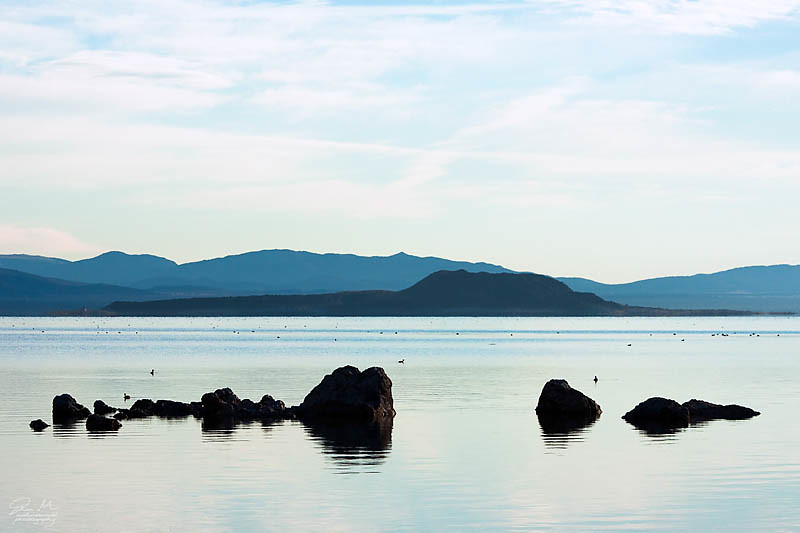
Mono Lake
Maiden Lane. In other words, where the red light district used to be. Some old storehouses are in the distance.
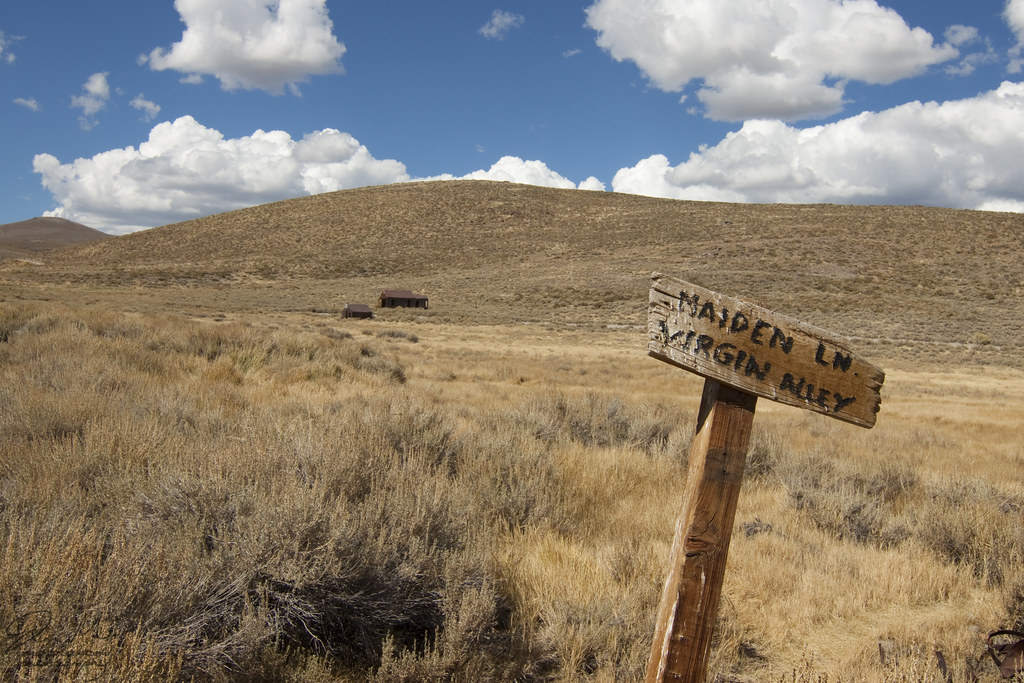
Looking East from Bodie. The road snakes around the hills into the North side of Bodie. It is liberally sprinkled with dumb RV drivers who did not spot the ‘unmade’ in the ‘unmade road’ part of the description of the road which leads here (seriously!). As we make our way into the town we see a lot of discarded mining equipment, including this large iron flywheel, all of which somehow escaped the scrapping which befell the rail tracks which used to pass through. In the background are the remaining stone buildings from Bodie’s very own Chinatown. A storm was a-comin!
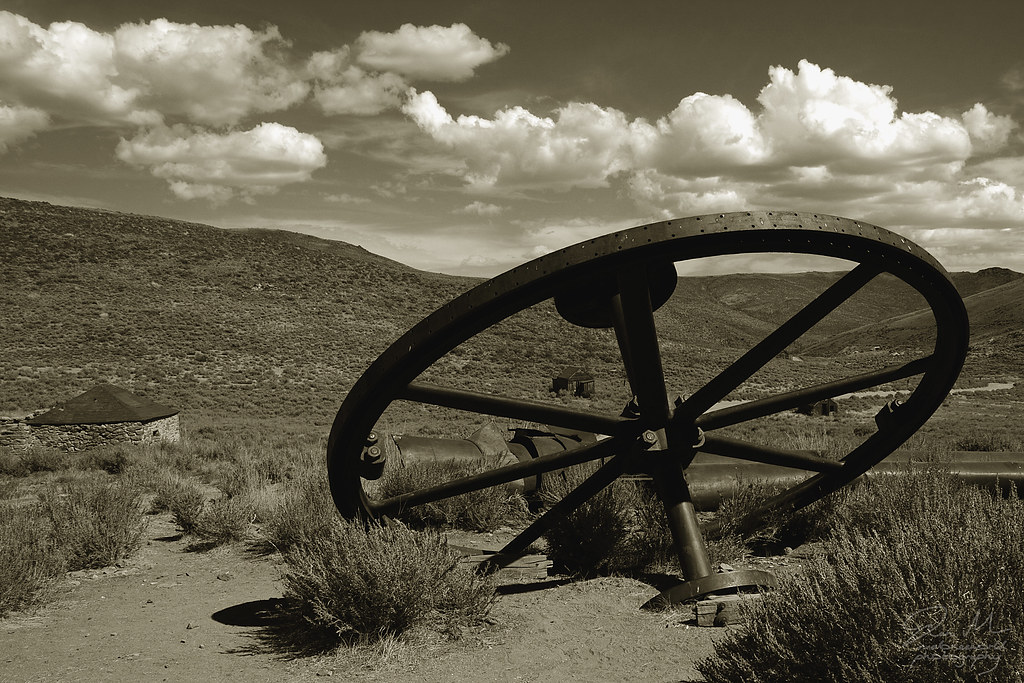
Some other bits of machinery from around the town.
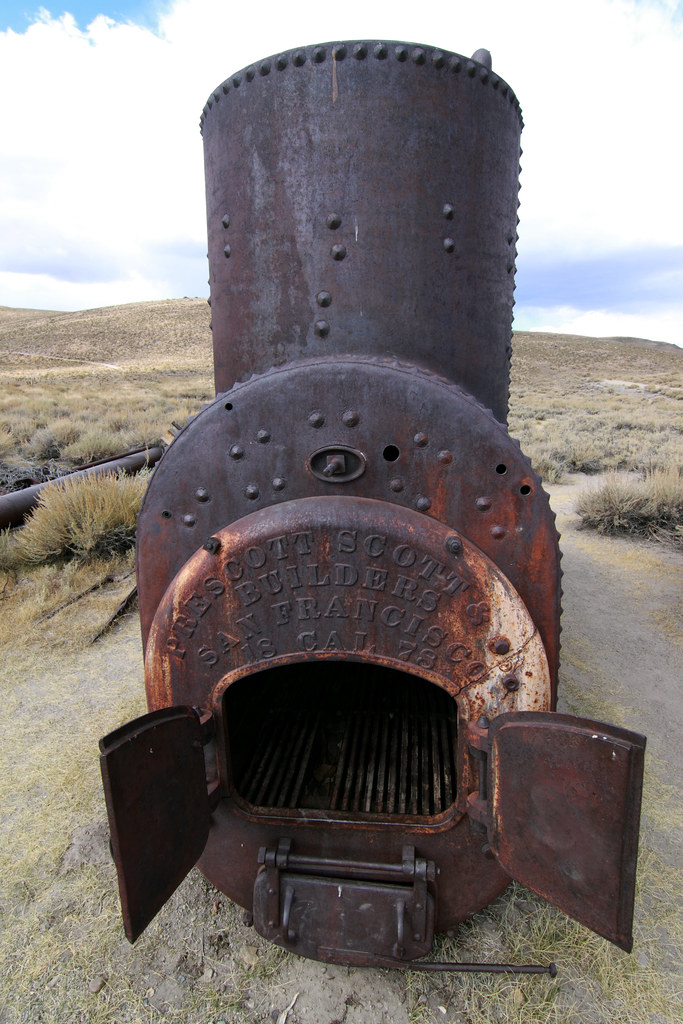
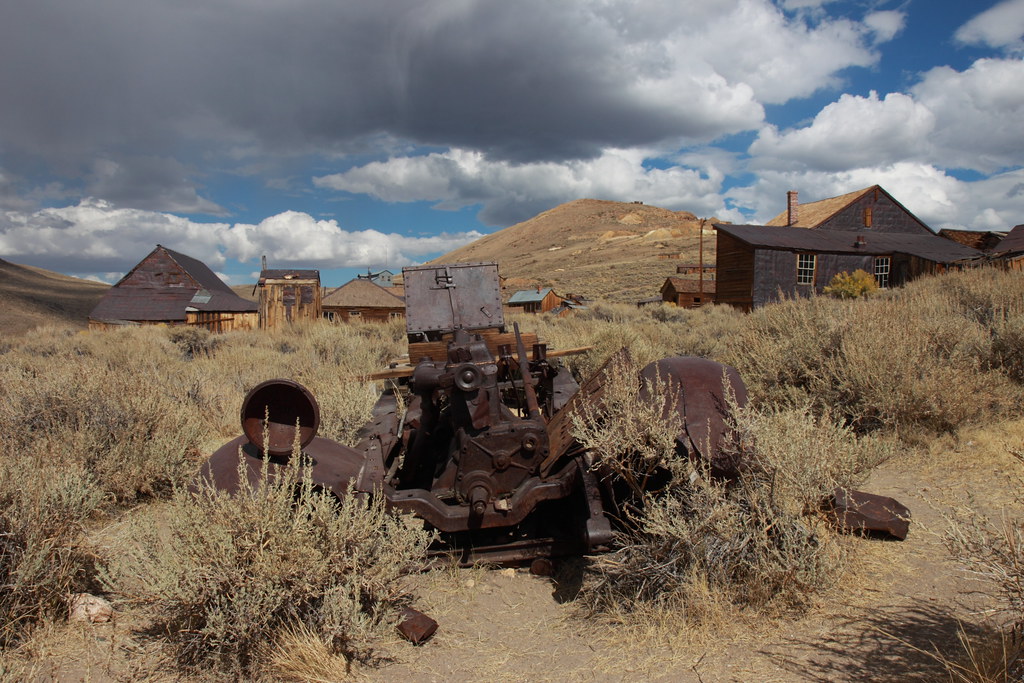
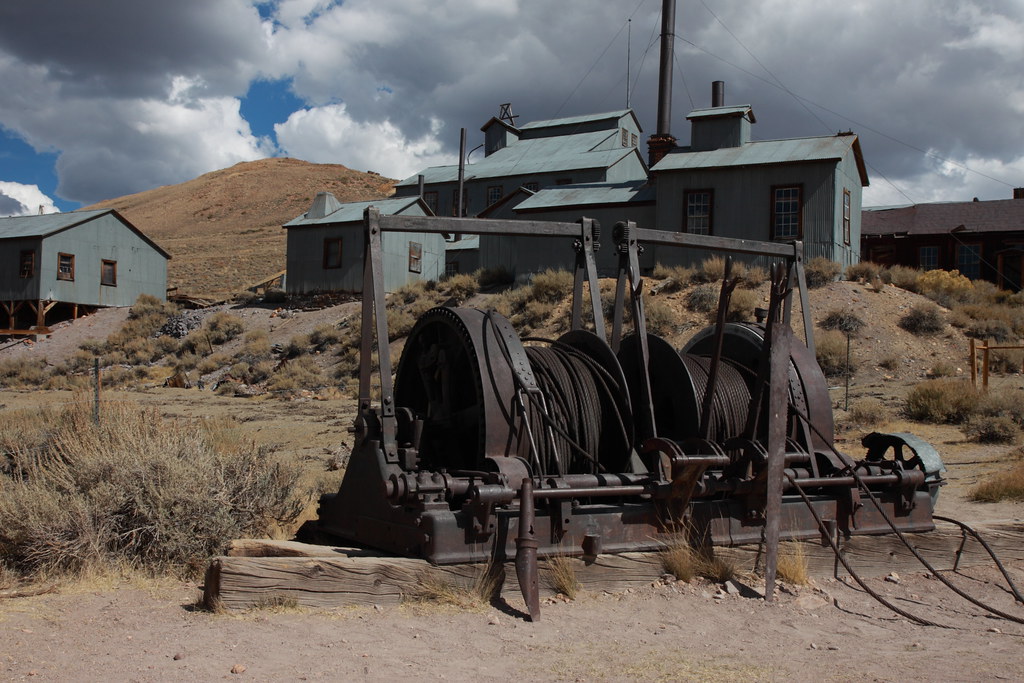
Now for some interiors of specific buildings:
The Smith’s. The blacksmith’s workshop, complete with numerous tools, extractor, bellows and anvil. It seems the bigger and heavier the item, or the more pointless, the more likely it would be abandoned here. Anvils are both big and heavy and (unless you happen to be a blacksmith) entirely pointless.
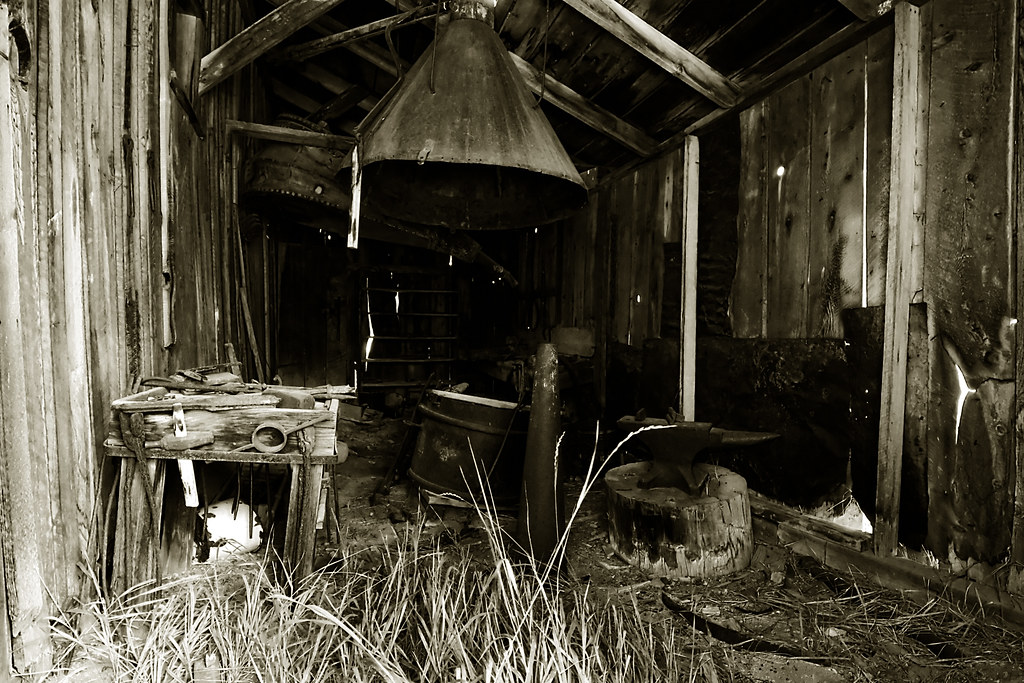
Faded wallhanging. An interior view of one of the many wooden homes left to crumble in Bodie. Despite freezing winters and scorching summers, many hang on.
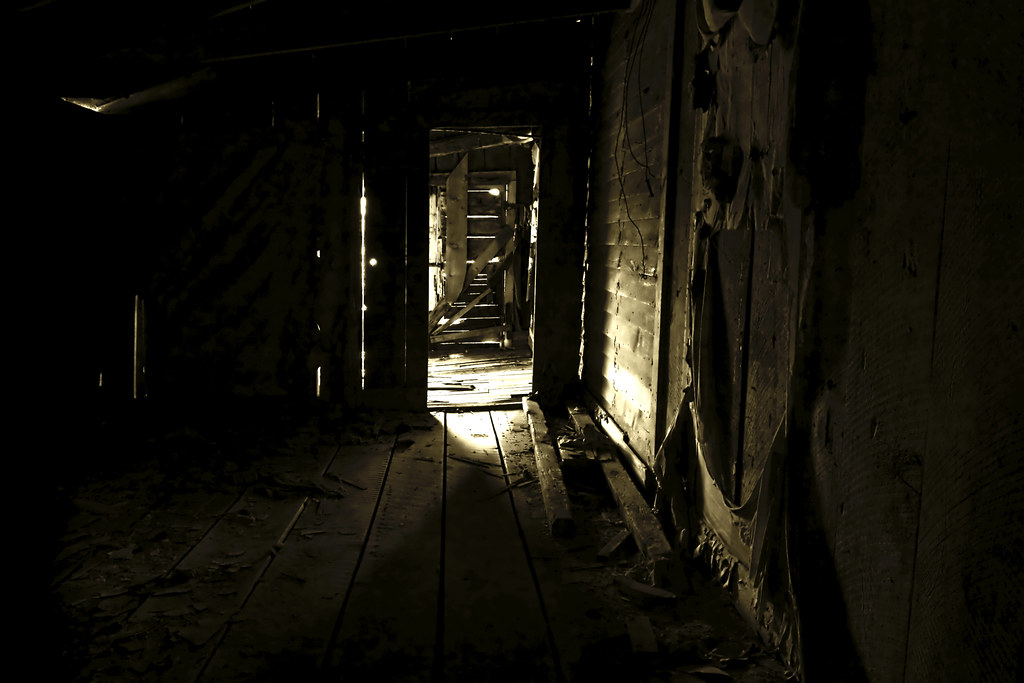
Peeling paper and an unmade bed. Taken through a window, so apologies for the extra ghosts in this picture, but it is very typical of the homes at Bodie.
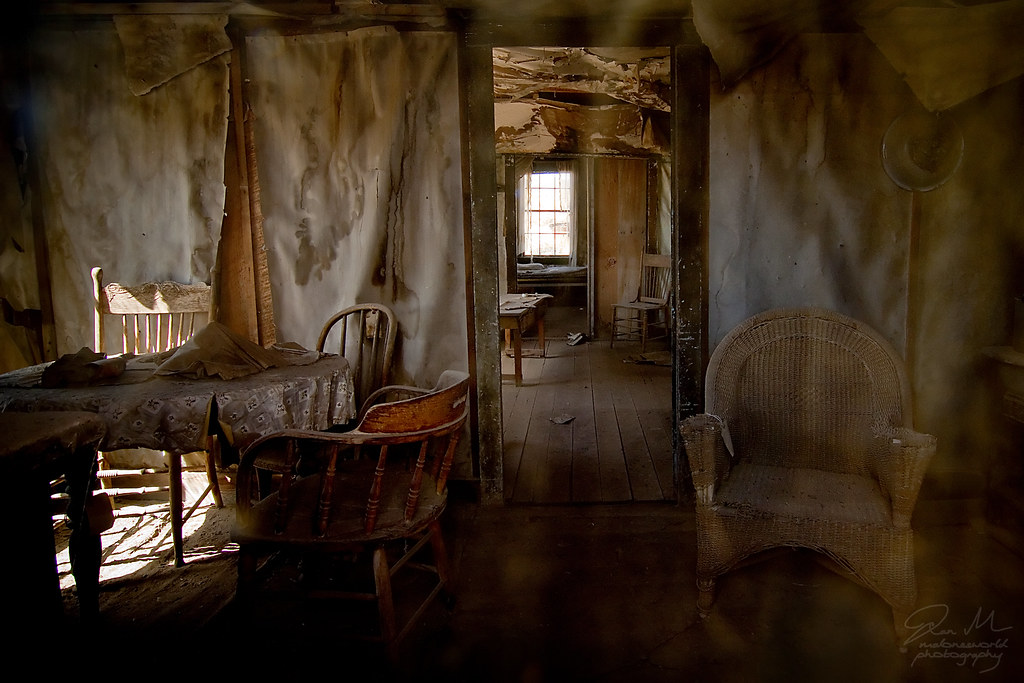
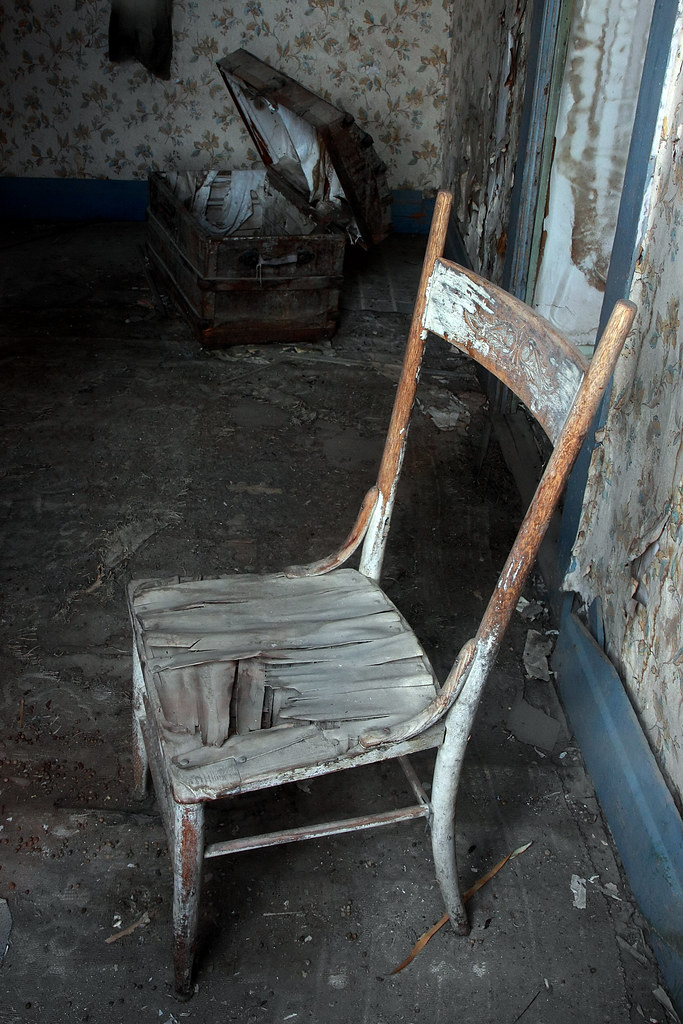
Rocker. Given the size of the beds, I assumed this to be a kid’s bedroom. I could only imagine what ma (or pa) must have been thinking as they sat in this rocker reading a bedtime story, knowing that tomorrow they would flee and leave everything they owned behind.
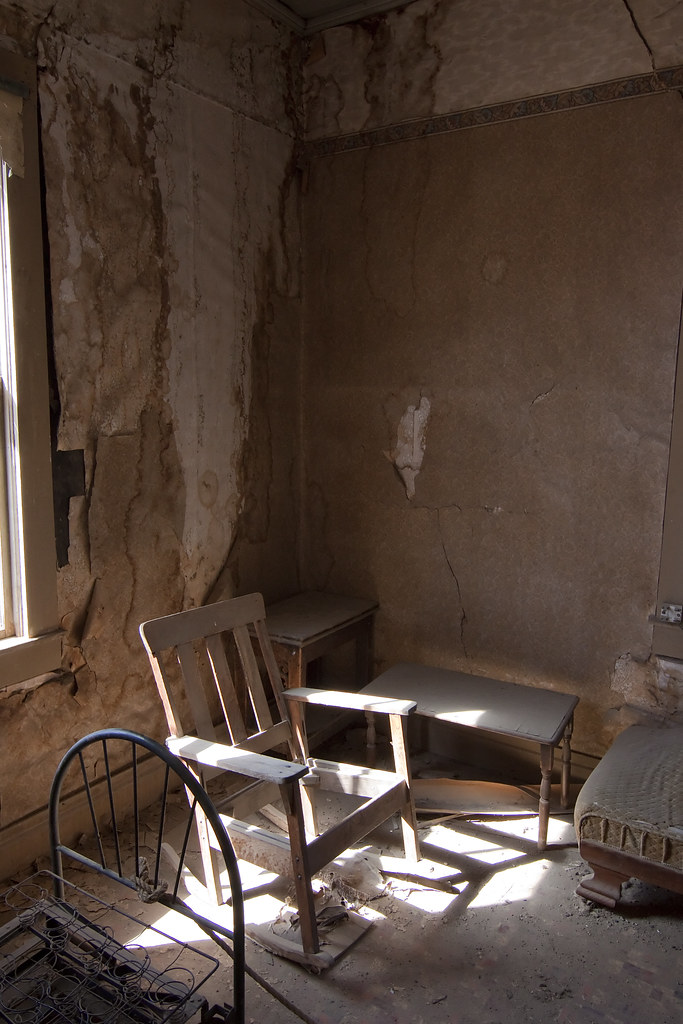
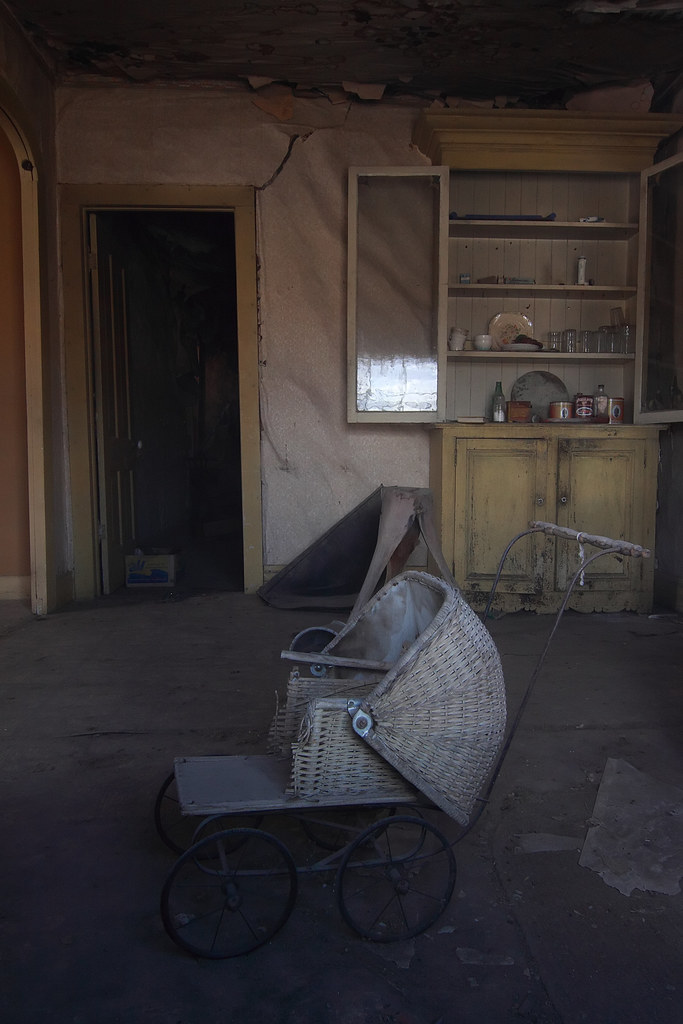
The Lab. Okay, it probably isn’t a lab – more of an apothecary or something like that. Still pretty cool though.
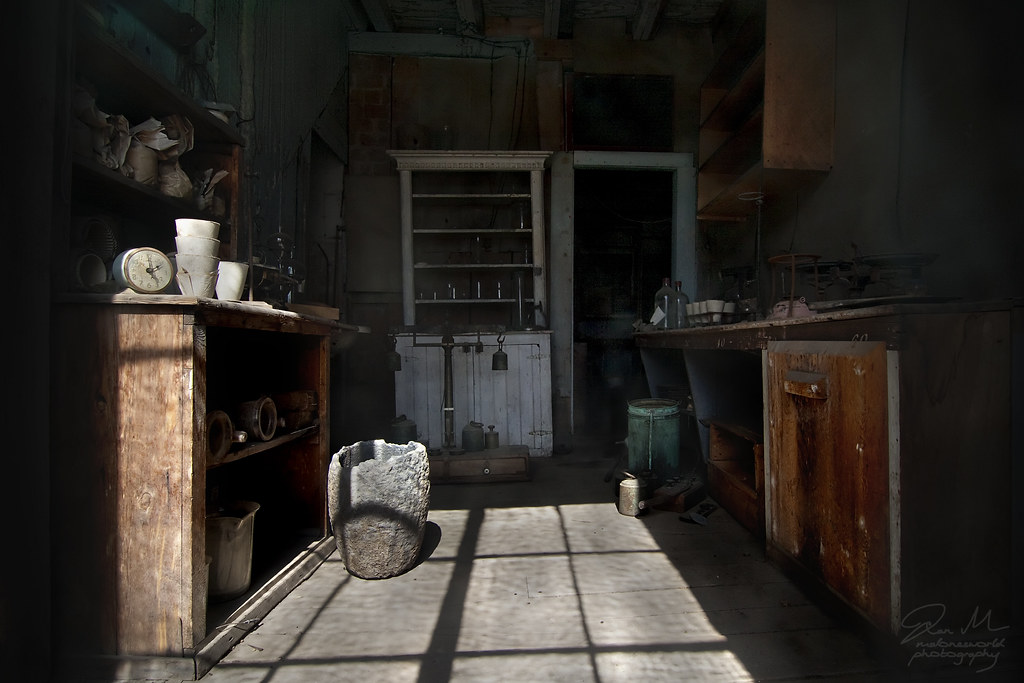
Drafts, Champion Universal No 514 and Grandma’s sewing machine. Just some of the things left in this house – I suspect someone before me ‘arranged’ the drafts board (checkers to any Americans reading this) on the small table on the left.
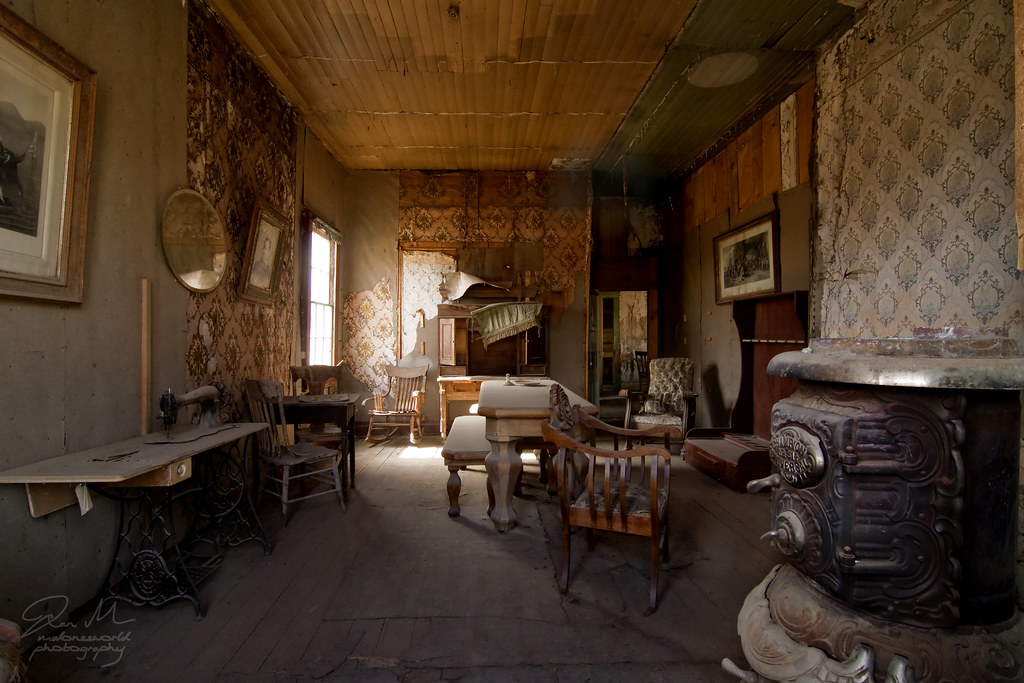
another sewing machine (they're in the same category as anvils, but for girls)

Inside Bodie Autos. There was a brief resurgence in visits to Bodie in 1915 or thereabouts as the automobile increased in popularity – at one time, Bodie had its own gas station and it still has a fairly well-stocked (although badly perished) car spares store. I expect the fanbelts and lubes are all a bit knackered now.
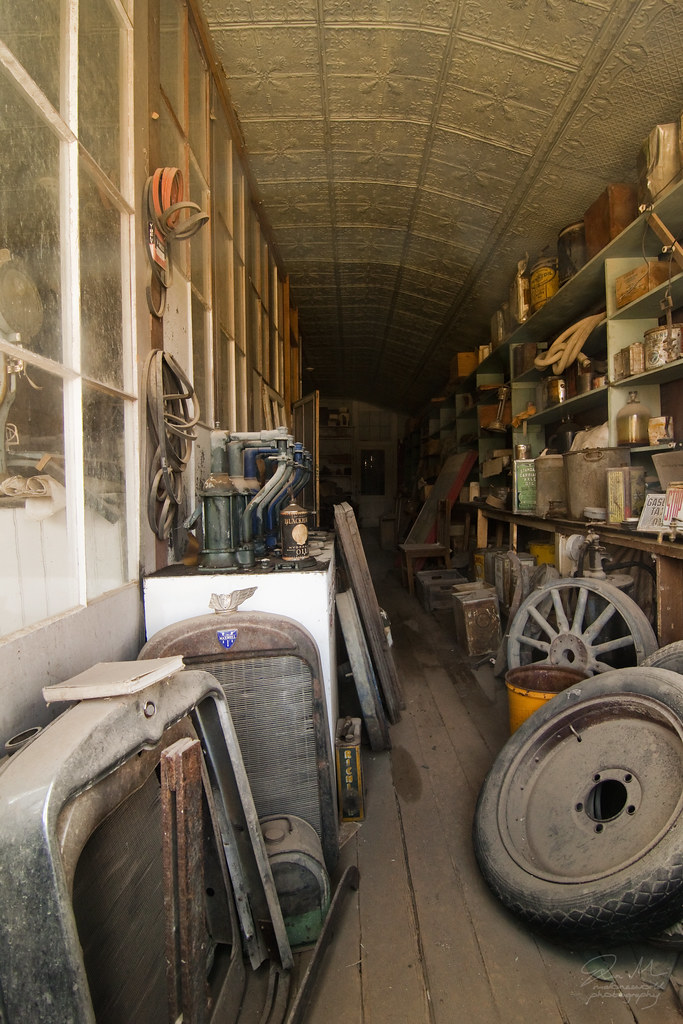
Gold(s) Gym. See what I did there? Anyway, the apparent American obsession with the body beautiful is nothing new, as the Bodie gym attests.
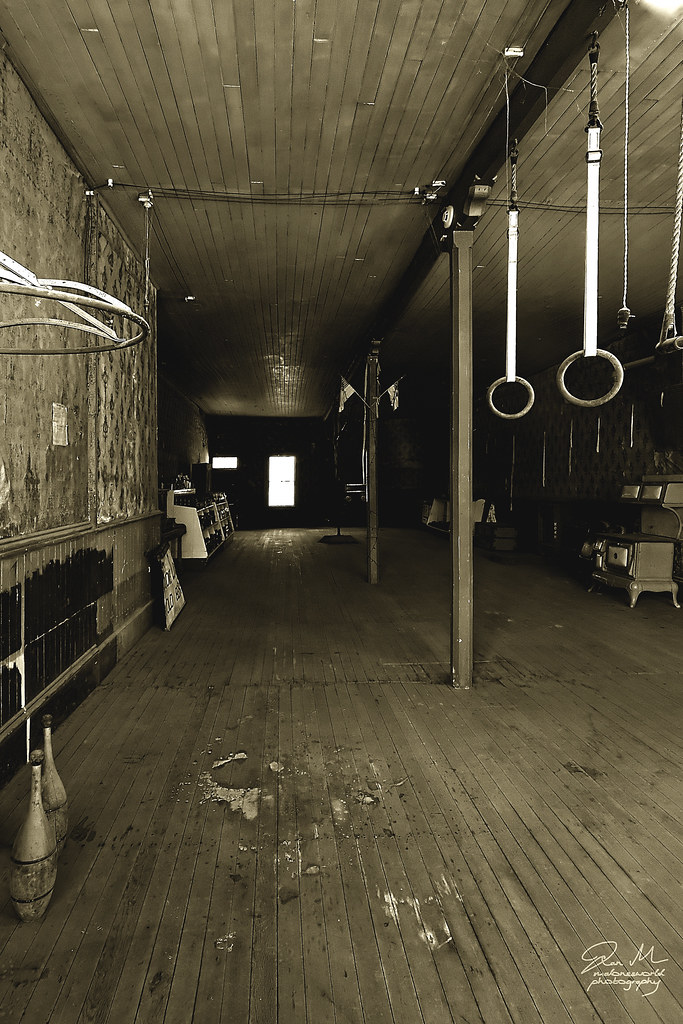
The café. Closed for business in October 1934, if the Goodyear calendar on the wall is anything to go by. The Depression and the lack of gold in Bodie took its toll.
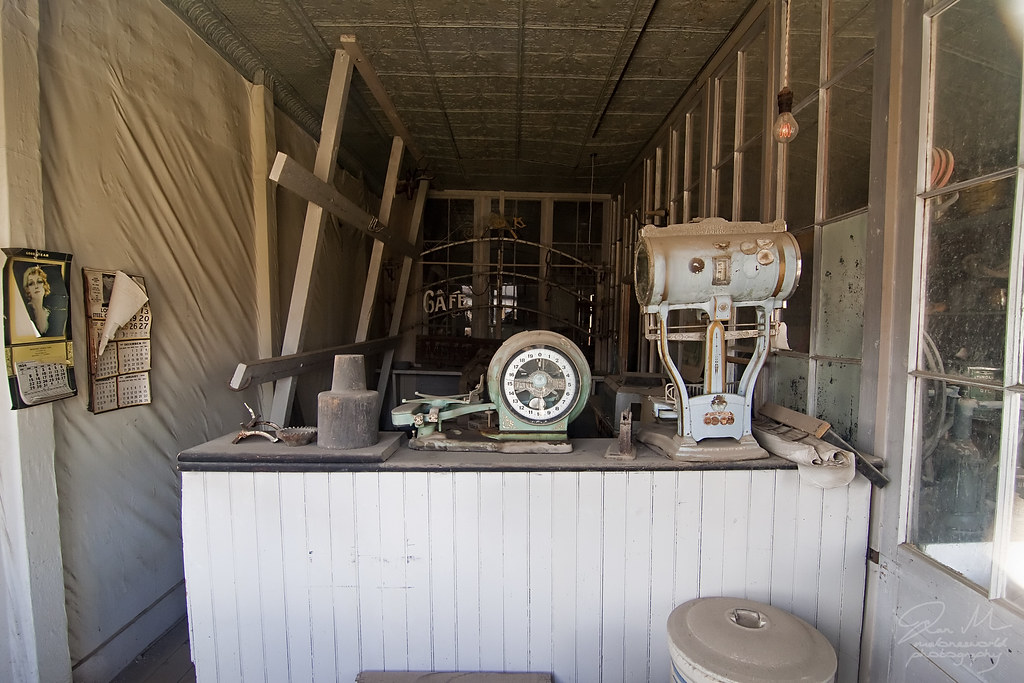
The Saloon Bar. Just one of the 65 bars which once served the town of Bodie. Billiard tables are not surprisingly in the same ‘leave behind’ category as anvils.
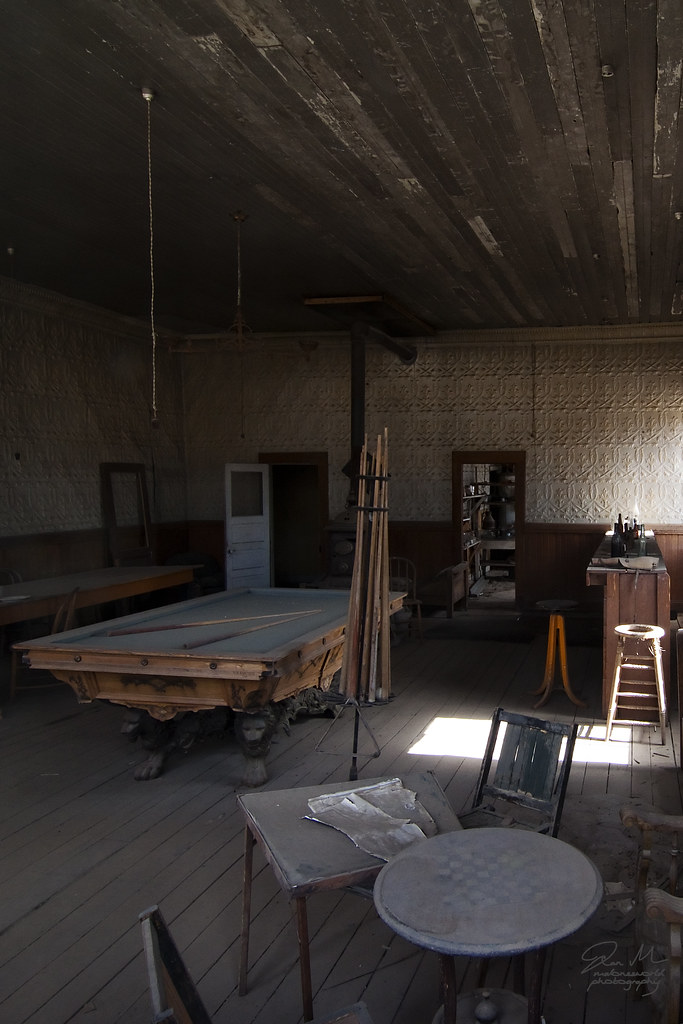
A wing-thing. A wing, of something. Weird.
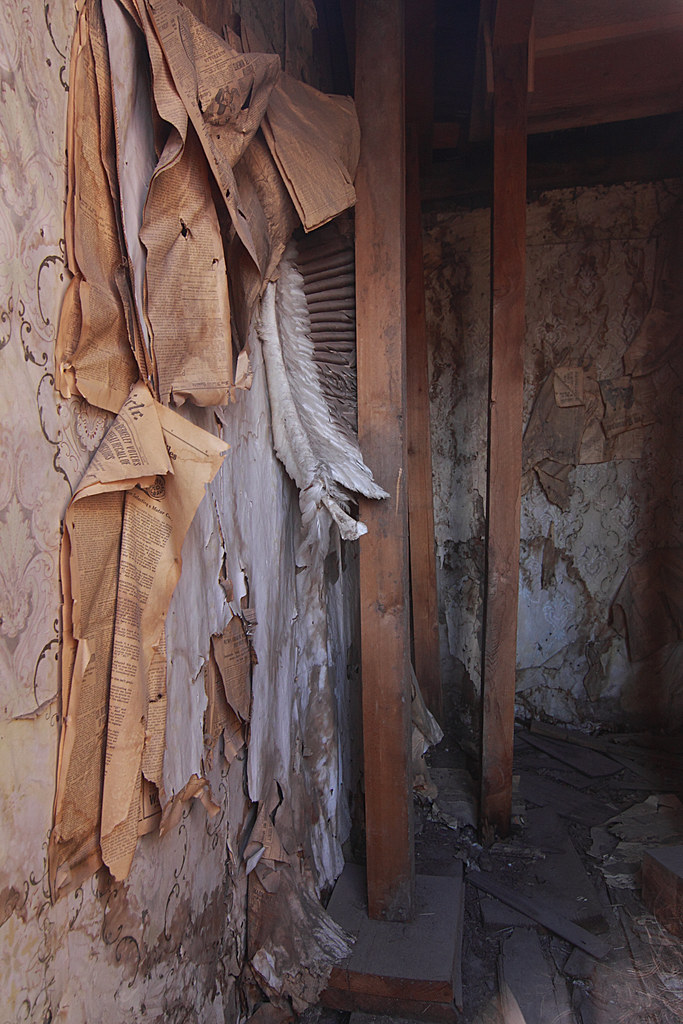
And now for some external views:
After the rush (2 ¼, inverted). First, apologies for indulging myself with an upsidedown tribute to one of my favourite American photographers, William Eggleston. Second, there are a bunch of cars just like this lying around the edges of Bodie. I do not know what make or model this car is (answers on a postcard please), but I do know that it has seen better days. A couple of the better sealed (and therefore better preserved) buildings are in the background.
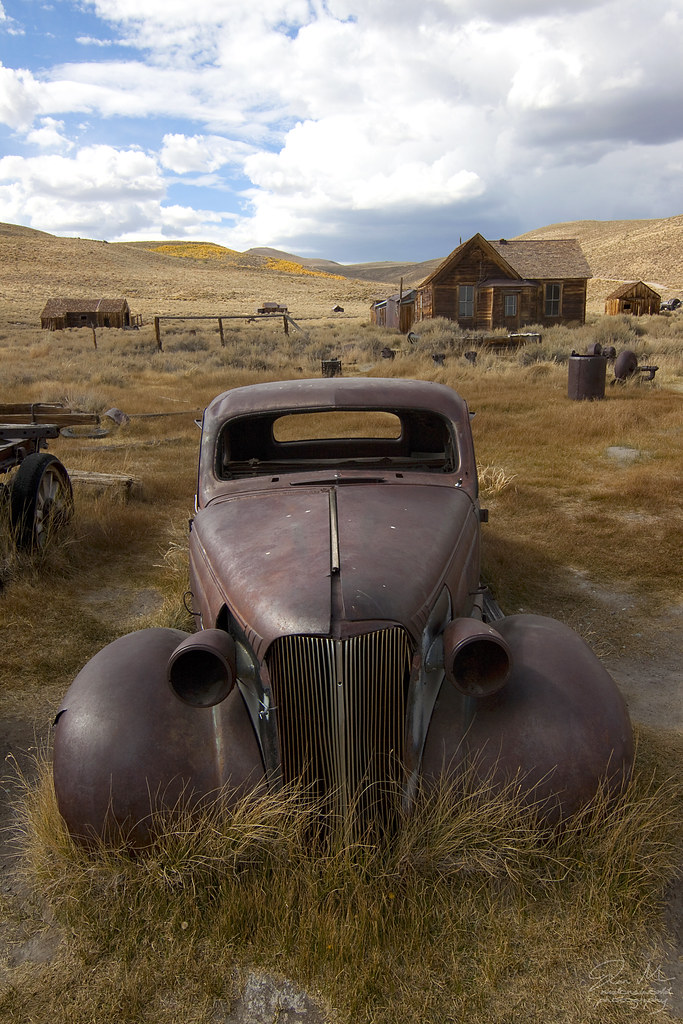
Bodie Bangers. It was like that when I found it, I promise.
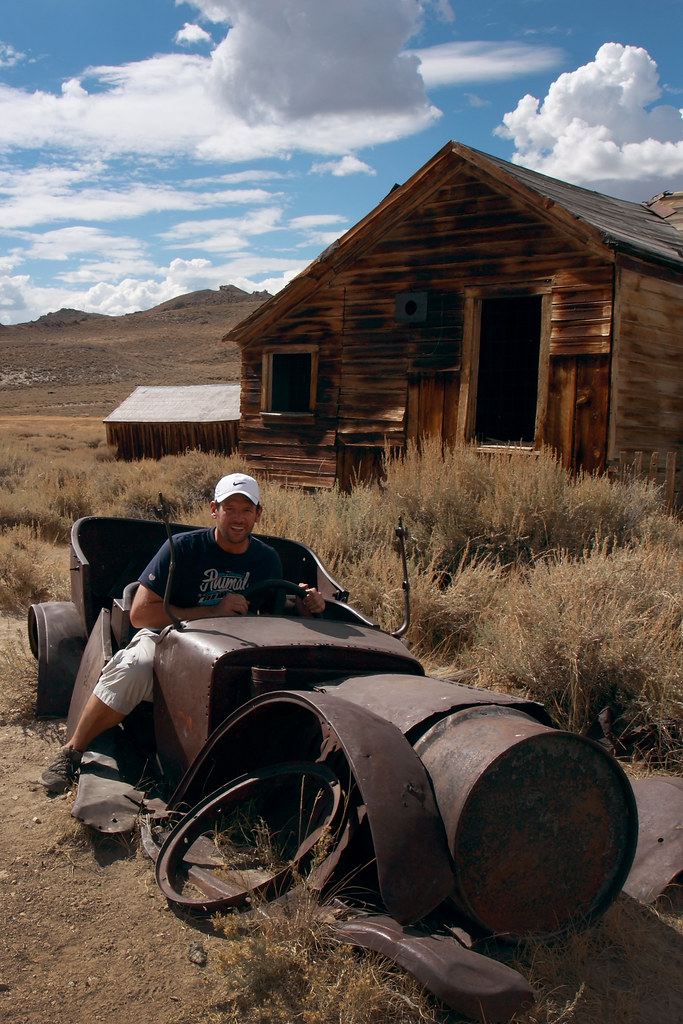
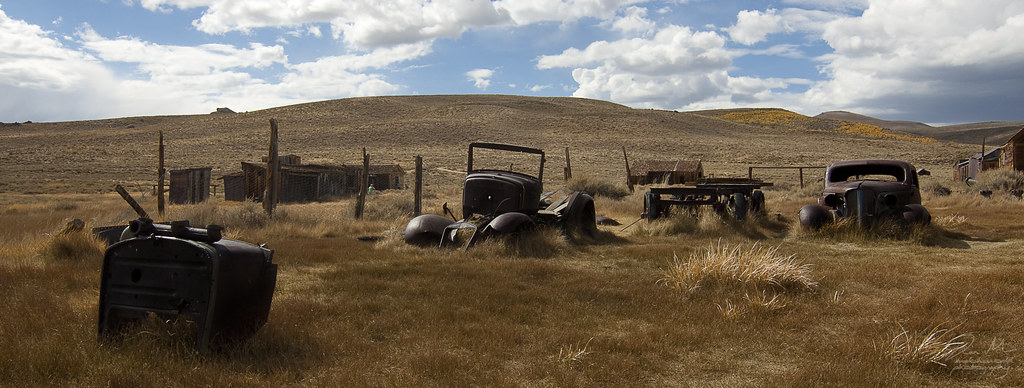

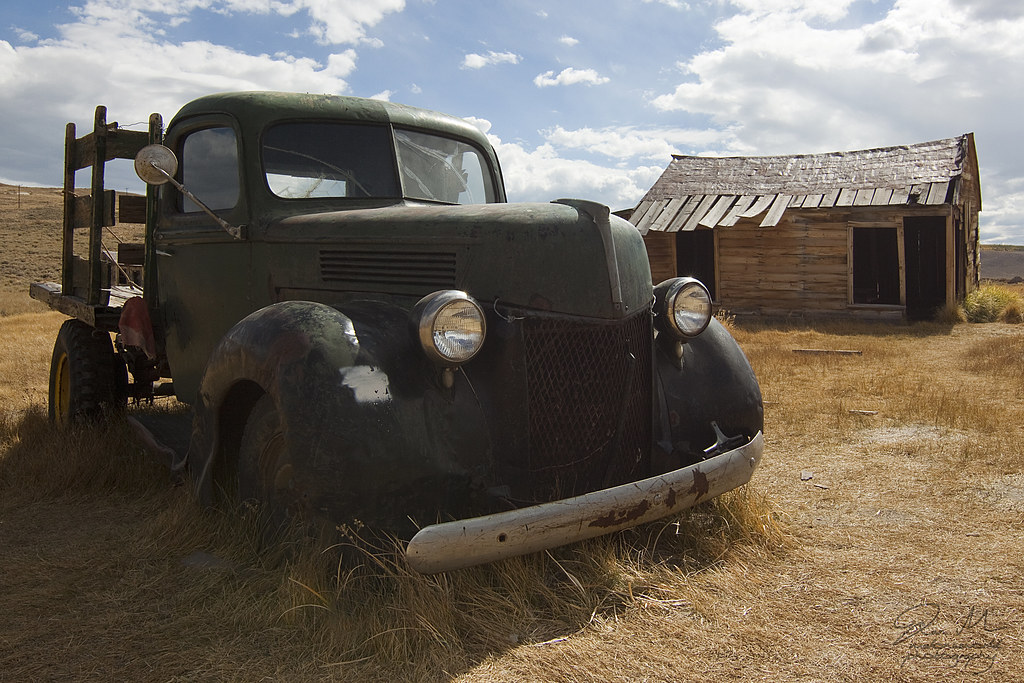
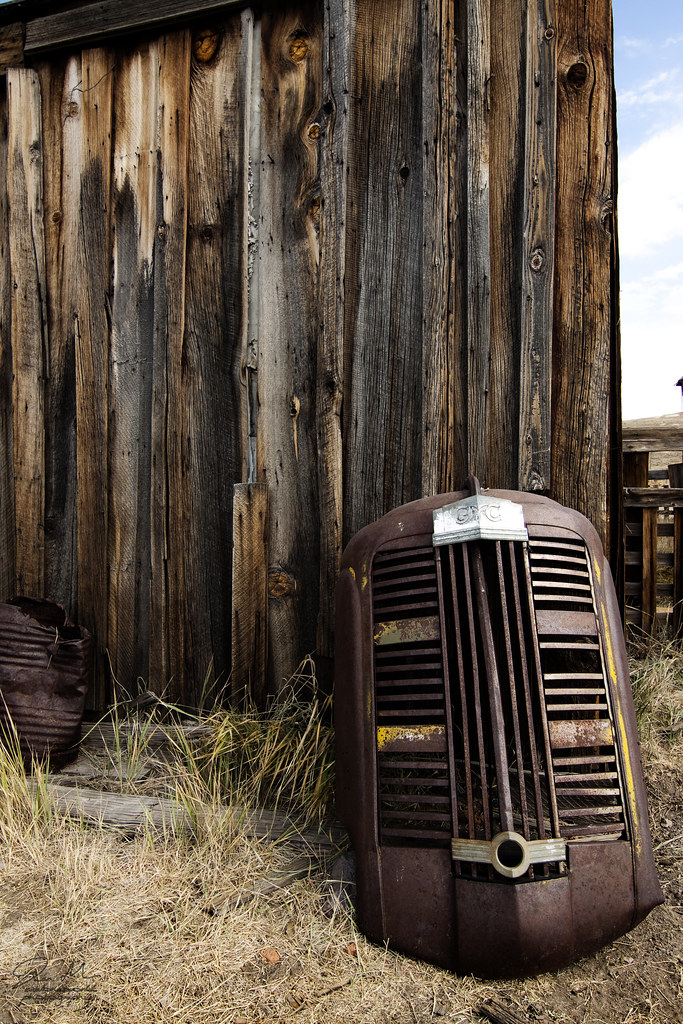
Grill by ian.malone, on Flickr
More of the town:
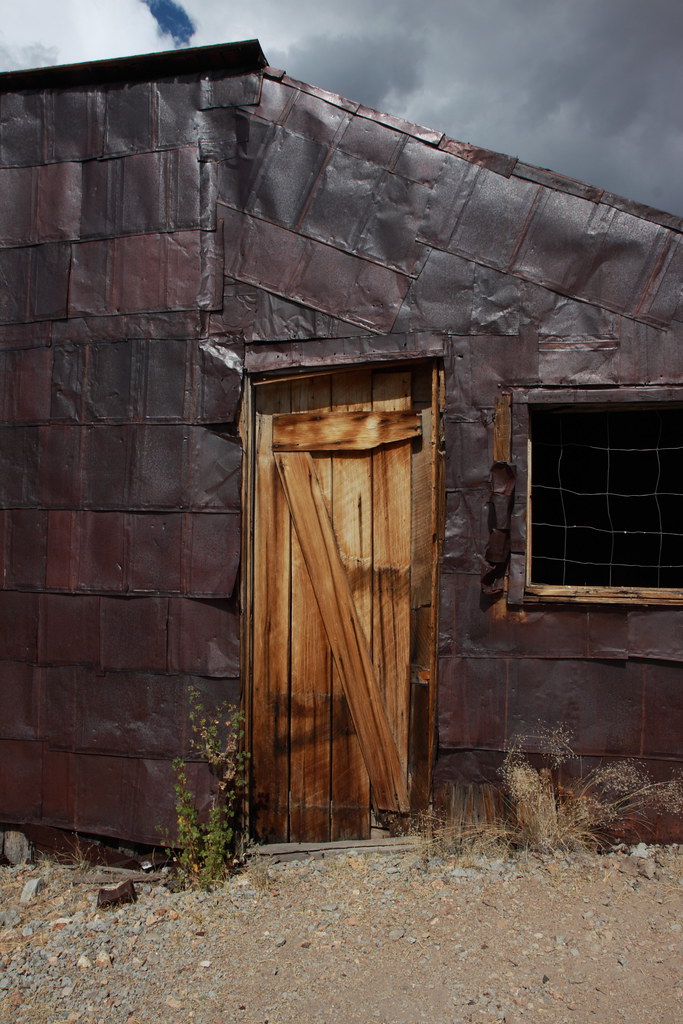

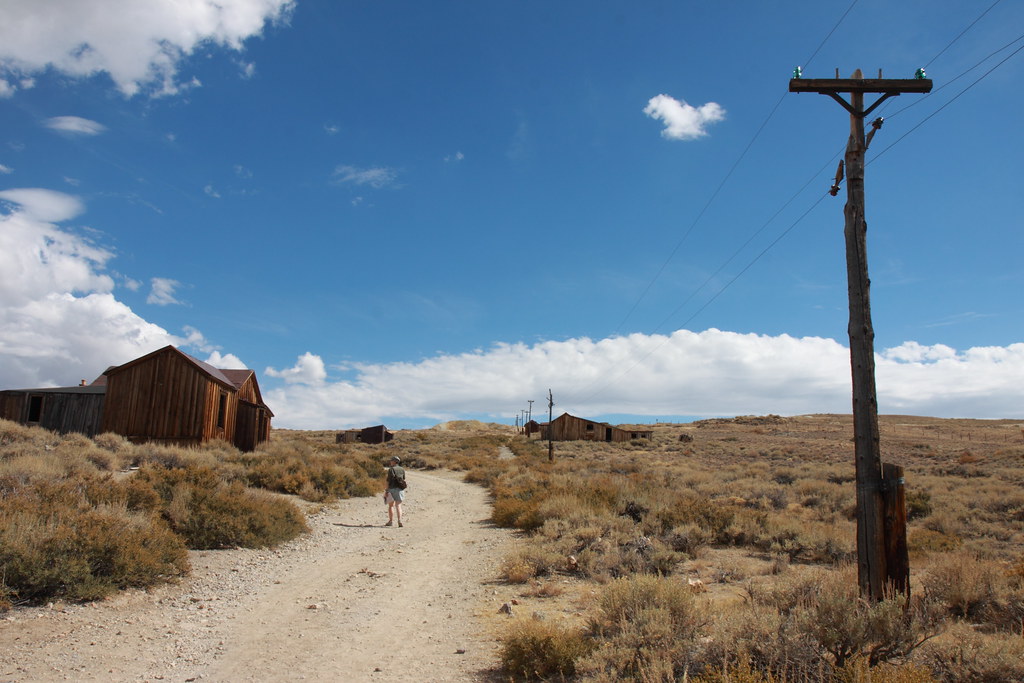
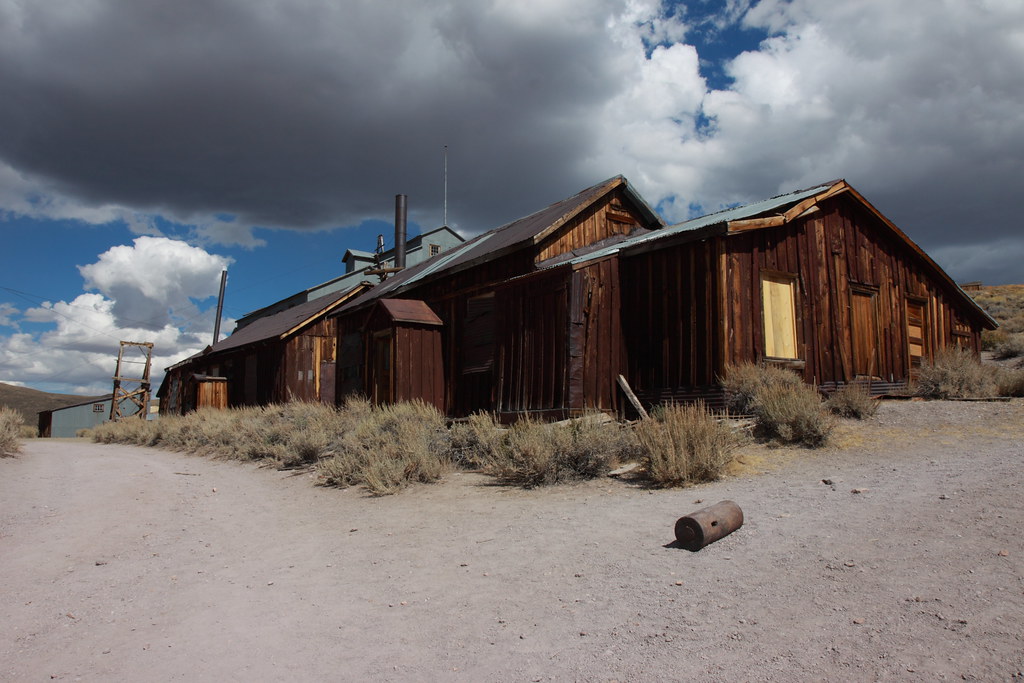

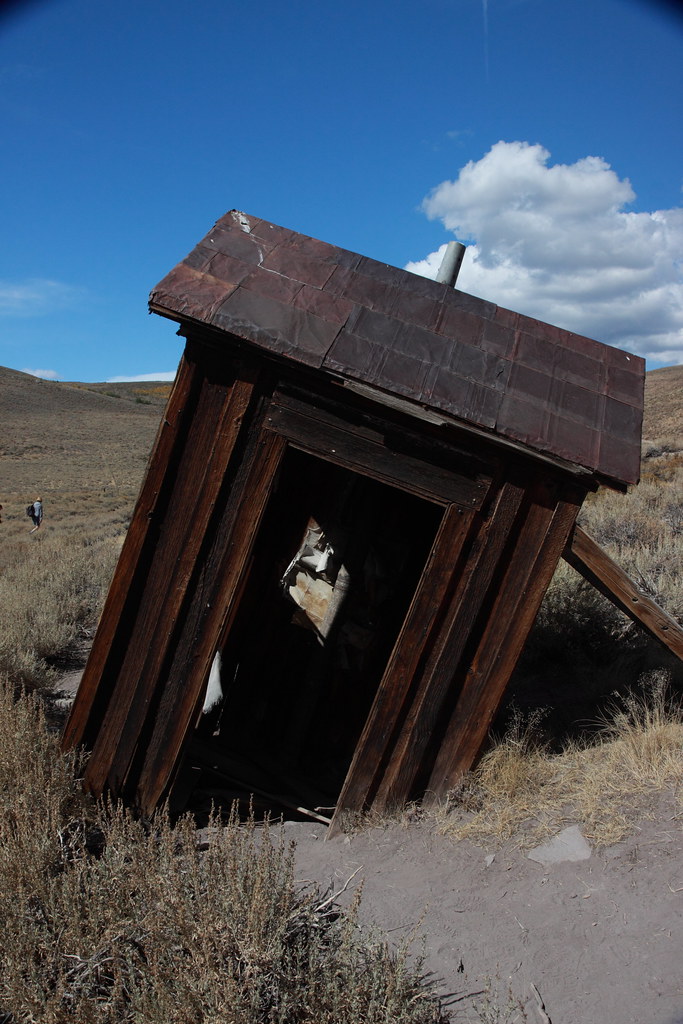

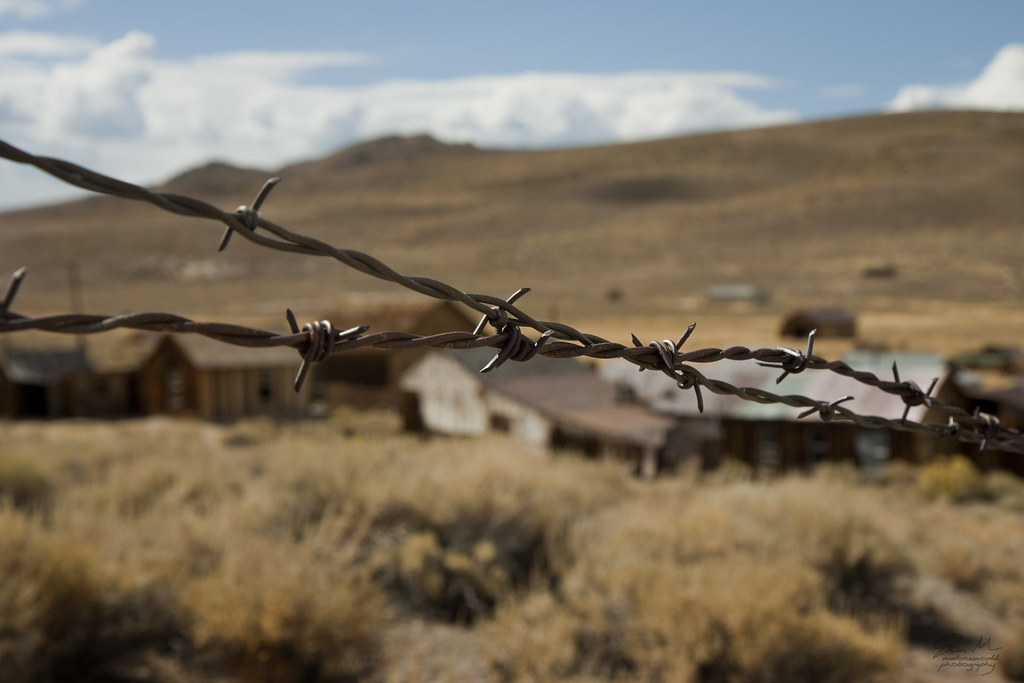
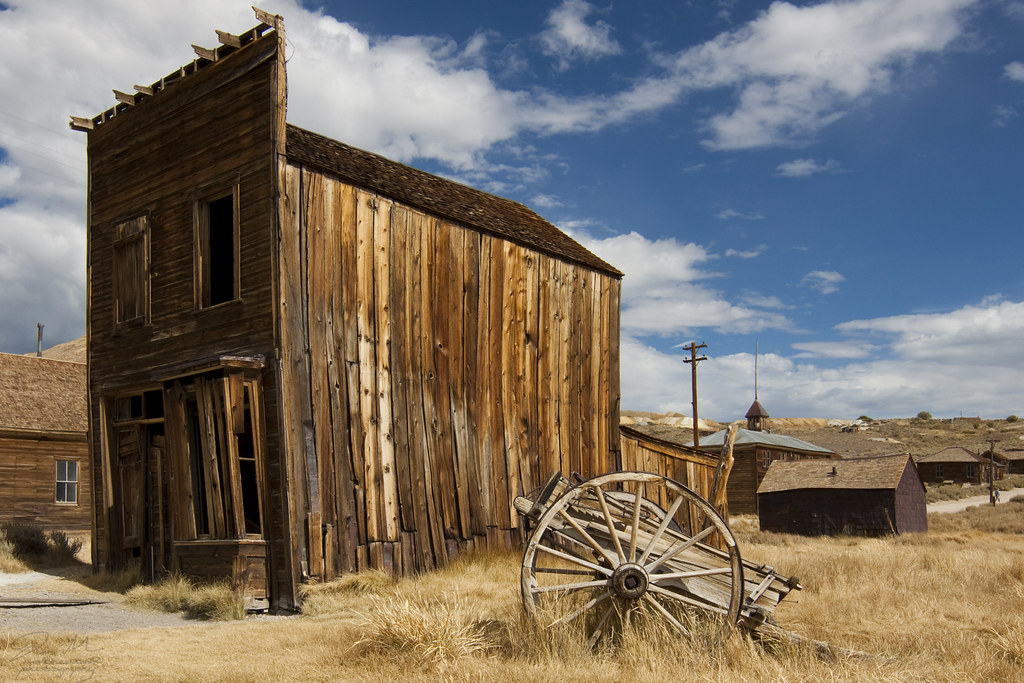
The Church.
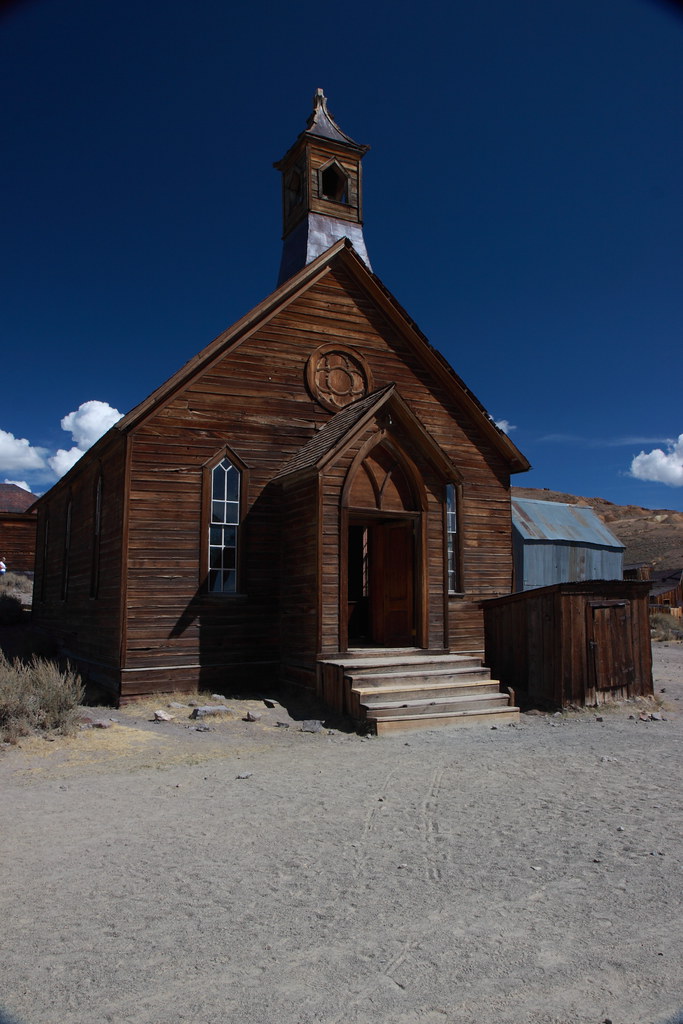

Apparently the frame on the wall (in the middle of the shot) used to hold a canvas reciting the 10 commandments. "Thou Shalt Not Steal" obviously meant nothing to the chavs who pinched it.

The School.
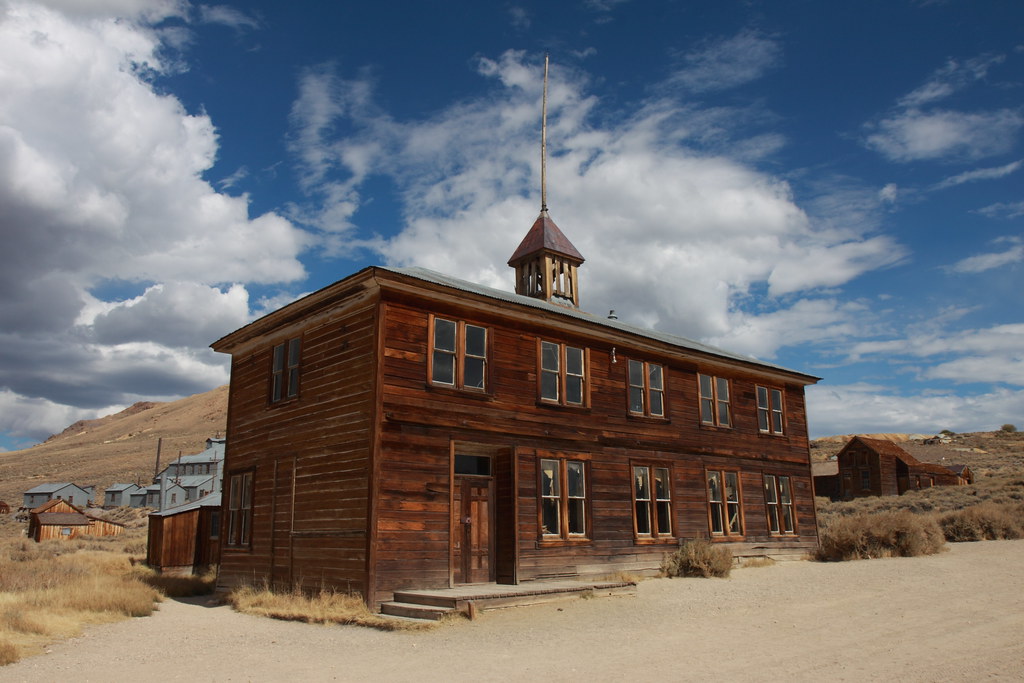
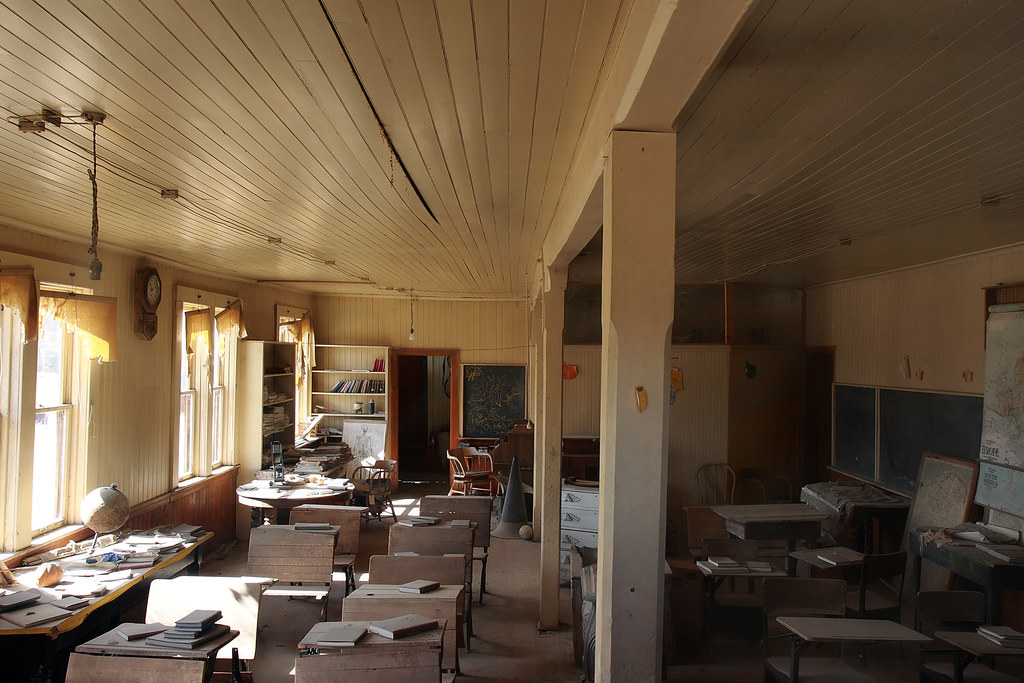
The Bank.
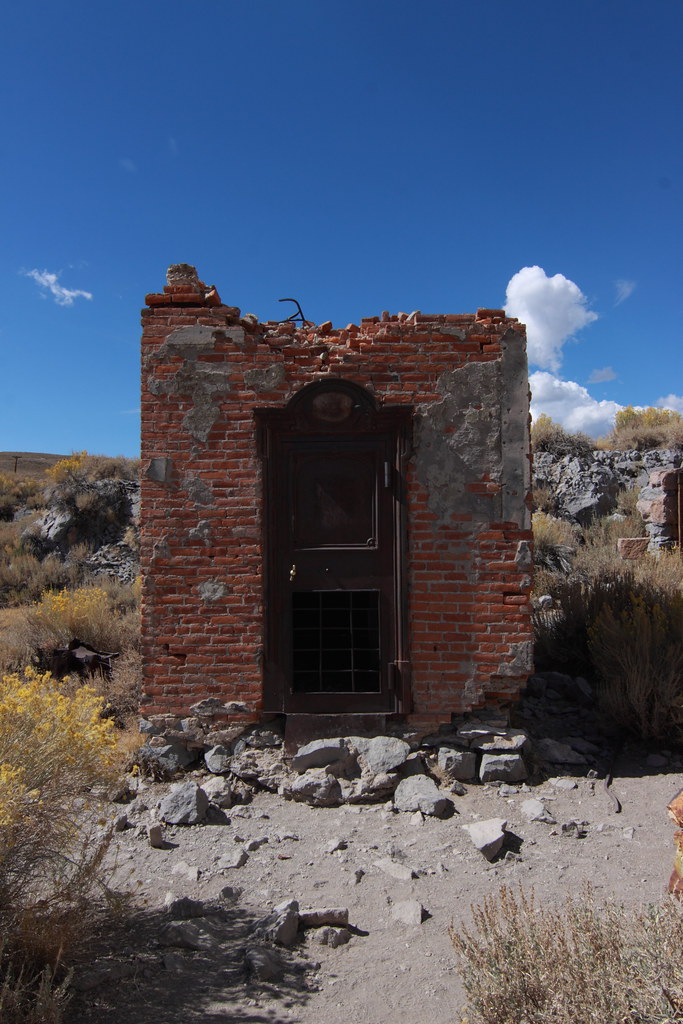

The Jail.
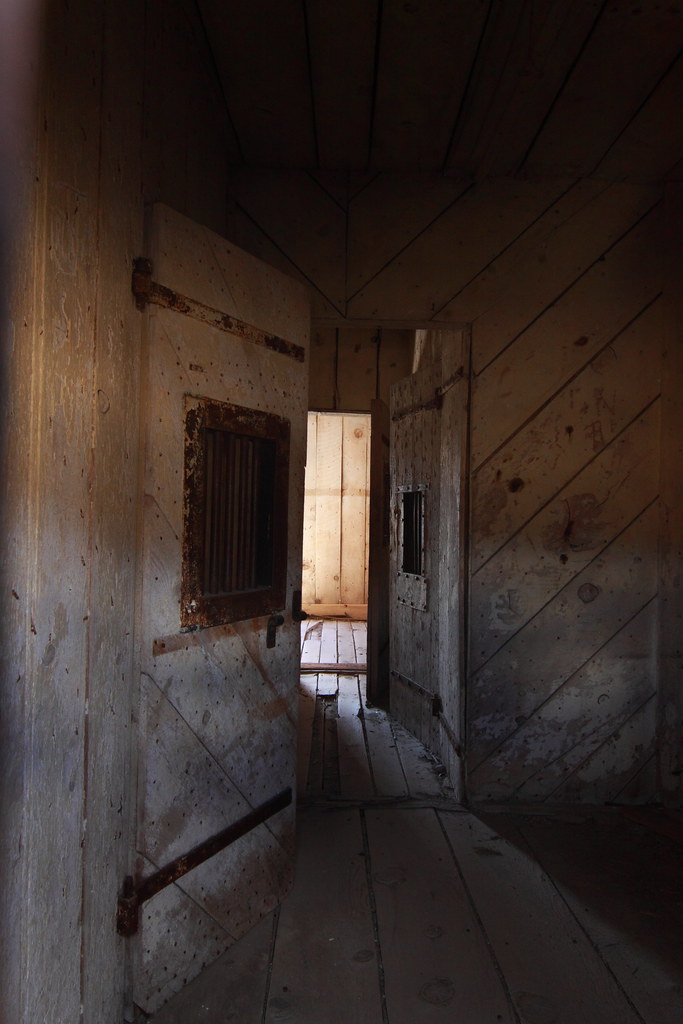
The Mine - apparently locked tight and totally OOB when I visited, and my other half was not up for an unsanctioned ramble.


Graveyard

------------------------------------------------------------------------------------------------------------------------------
FOOTNOTE:
Bodie has been a California State Park since 1962 and now boasts a population of around 8 in the summer months, all employed by The California Department of Parks and Recreation or volunteers, who work hard to maintain the more than 170 buildings which can be found here it in a state of suspended decay – an interested thing to see when I come from a place where chavs are allowed to roam free and support the developers in their claims that our history should be knocked flat and redeveloped. That could change though - in 2009, Bodie was scheduled to be closed, but the Californian state was able to make a budget compromise that enabled the state's Parks Closure Commission to allow it to remain open, at least during 2009–2010. Further cuts still threaten its future.
http://www.recordcourier.com/article/20110227/NEWS/110229918/1062&ParentProfile=1049
------------------------------------------------------------------------------------------------------------------------------
Endnote
*I appreciate this is a report of a fairly well maintained and well-visited site, and I didn't need to climb razor wire, evade psycho guards or back-flip fences to see, but I found the place so interesting and in such eye popping condition, and as there wasn’t anything on Derelict Places about it, I thought I should share. IMHO, given that the place is still under threat and that it is such an important part of American history, the more reports and images of the place there are, the better. I think that's what taking pictures of these places is about - I hope you guys agree and enjoy my first 'proper' report*
------------------------------------------------------------------------------------------------------------------------------
------------------------------------------------------------------------------------------------------------------------------
Back in 1859, prospector W.S. Bodie (either Wakeman, William or Waterman S Body, Bodey or Bodie, depending on which story you believe) headed from Lee Vining, California, USA into the surrounding hills in search of a little fame and fortune. Several miles north of Mono Lake he struck gold, triggering the rapid growth of the mining boom town which came to be called Bodie in his name, and what is now perhaps America’s best preserved ghost town.
http://maps.google.com/maps?ll=38.2...&lci=org.wikipedia.en&q=38.212222,-119.012222
Unfortunately for WS, he died in a severe snow storm that same winter and, although his fame was now guaranteed, he never lived to see the town which took his name, nor the fortune he sought - that fell to the mine company owners who followed him.
The ghosts of gold rush towns litter the USA, but as boom towns go Bodie’s story is pretty impressive, growing from WS and three companions to a town of around 10,000 residents by the mid 1870s. By 1882, the big gold strikes were done and the town was already shrinking fast as the gold started to run out.
Bodie is a remote and inhospitable place: it’s 13 miles east of Highway 395 on Highway 270 – the last three miles of which is still unpaved – and sits at 8,375 feet above sea level. As a result, it is HOT and very dry in the summer and although you don’t have to drive a 4x4, it certainly helps. In the winter, Bodie is often completely snowbound, with deep snow drifts and whiteouts driven by high winds. Bodie regularly appears on the list of the coldest place in the United States, with temperatures frequently below -18c and average January temps between of -15c to 4c. In the winter, if you don’t have skis, snowshoes or a snowmobile, you won’t be visiting.
Without the gold to keep them there, the miners went elsewhere, and as the miners left the people who supported their needs, including bankers, shopkeepers, inn keepers, laundrymen, hookers, teachers and stock workers (in no particular order) began to leave too. Local land owners charged those leaving a fee for crossing their land and their rivers, per person and per pound. This was fine if you had the wealth of gold to support you, but without it, it was an expense which made it far cheaper for people to buy new when they got where they were going than to carry their belongings with them. For this reason, many of the buildings in Bodie are mini-museums in their own right – faded curtains hang in windows, washing-up sits unfinished in basins and calendars from the 1930s hang suspended in time, never to be turned.
A mine owner started buying the place up in the late 30's, but it soon became threatened by vandals and visitors - in the 1940s - so the owner started paying guards. I suppose it has been an 'urbex' site since waaaaay before the phrase was coined, so as well as being a pretty important site as far as the history of the US goes, it's part of the history of urbex (sort of!) .
Walking around Bodie is very weird – it’s like being in a Wild West film, and entirely unlike any American tourist spot (or Urbex site come to think of it) I have ever visited. The absolute bare minimum is done to preserve the buildings and keep the place authentic. The rest is unsanitised: broken glass, barbed wire and rusted cans litter the floor, dust and cobwebs accumulate in the buildings and splinters and bent nails protrude from walls and floors – this is not ‘Disneyland America’. Money for the preservation/protection of this place is very tight. More effort is made to protect what ‘key’ buildings remain (the church for example would not look particularly out of place in some small towns in the States), but for some other key buildings are all but gone (the bank for example is little more than a doorway now). Even here, it is possible to get ‘off-the beaten track’ and enter buildings and areas which other visitors might not (if you get my drift).
Now for some pictures!
Mono Lake near Lee Vining – from whence WS came. This is Mono Lake, just to set the scene. Some 19 miles off over the darker coloured island in the middle of the lake is our destination, Bodie Ghost Town.

Mono Lake
Maiden Lane. In other words, where the red light district used to be. Some old storehouses are in the distance.

Looking East from Bodie. The road snakes around the hills into the North side of Bodie. It is liberally sprinkled with dumb RV drivers who did not spot the ‘unmade’ in the ‘unmade road’ part of the description of the road which leads here (seriously!). As we make our way into the town we see a lot of discarded mining equipment, including this large iron flywheel, all of which somehow escaped the scrapping which befell the rail tracks which used to pass through. In the background are the remaining stone buildings from Bodie’s very own Chinatown. A storm was a-comin!

Some other bits of machinery from around the town.



Now for some interiors of specific buildings:
The Smith’s. The blacksmith’s workshop, complete with numerous tools, extractor, bellows and anvil. It seems the bigger and heavier the item, or the more pointless, the more likely it would be abandoned here. Anvils are both big and heavy and (unless you happen to be a blacksmith) entirely pointless.

Faded wallhanging. An interior view of one of the many wooden homes left to crumble in Bodie. Despite freezing winters and scorching summers, many hang on.

Peeling paper and an unmade bed. Taken through a window, so apologies for the extra ghosts in this picture, but it is very typical of the homes at Bodie.


Rocker. Given the size of the beds, I assumed this to be a kid’s bedroom. I could only imagine what ma (or pa) must have been thinking as they sat in this rocker reading a bedtime story, knowing that tomorrow they would flee and leave everything they owned behind.


The Lab. Okay, it probably isn’t a lab – more of an apothecary or something like that. Still pretty cool though.

Drafts, Champion Universal No 514 and Grandma’s sewing machine. Just some of the things left in this house – I suspect someone before me ‘arranged’ the drafts board (checkers to any Americans reading this) on the small table on the left.

another sewing machine (they're in the same category as anvils, but for girls)

Inside Bodie Autos. There was a brief resurgence in visits to Bodie in 1915 or thereabouts as the automobile increased in popularity – at one time, Bodie had its own gas station and it still has a fairly well-stocked (although badly perished) car spares store. I expect the fanbelts and lubes are all a bit knackered now.

Gold(s) Gym. See what I did there? Anyway, the apparent American obsession with the body beautiful is nothing new, as the Bodie gym attests.

The café. Closed for business in October 1934, if the Goodyear calendar on the wall is anything to go by. The Depression and the lack of gold in Bodie took its toll.

The Saloon Bar. Just one of the 65 bars which once served the town of Bodie. Billiard tables are not surprisingly in the same ‘leave behind’ category as anvils.

A wing-thing. A wing, of something. Weird.

And now for some external views:
After the rush (2 ¼, inverted). First, apologies for indulging myself with an upsidedown tribute to one of my favourite American photographers, William Eggleston. Second, there are a bunch of cars just like this lying around the edges of Bodie. I do not know what make or model this car is (answers on a postcard please), but I do know that it has seen better days. A couple of the better sealed (and therefore better preserved) buildings are in the background.

Bodie Bangers. It was like that when I found it, I promise.





Grill by ian.malone, on Flickr
More of the town:









The Church.


Apparently the frame on the wall (in the middle of the shot) used to hold a canvas reciting the 10 commandments. "Thou Shalt Not Steal" obviously meant nothing to the chavs who pinched it.

The School.


The Bank.


The Jail.

The Mine - apparently locked tight and totally OOB when I visited, and my other half was not up for an unsanctioned ramble.


Graveyard

------------------------------------------------------------------------------------------------------------------------------
FOOTNOTE:
Bodie has been a California State Park since 1962 and now boasts a population of around 8 in the summer months, all employed by The California Department of Parks and Recreation or volunteers, who work hard to maintain the more than 170 buildings which can be found here it in a state of suspended decay – an interested thing to see when I come from a place where chavs are allowed to roam free and support the developers in their claims that our history should be knocked flat and redeveloped. That could change though - in 2009, Bodie was scheduled to be closed, but the Californian state was able to make a budget compromise that enabled the state's Parks Closure Commission to allow it to remain open, at least during 2009–2010. Further cuts still threaten its future.
http://www.recordcourier.com/article/20110227/NEWS/110229918/1062&ParentProfile=1049
------------------------------------------------------------------------------------------------------------------------------
Endnote
*I appreciate this is a report of a fairly well maintained and well-visited site, and I didn't need to climb razor wire, evade psycho guards or back-flip fences to see, but I found the place so interesting and in such eye popping condition, and as there wasn’t anything on Derelict Places about it, I thought I should share. IMHO, given that the place is still under threat and that it is such an important part of American history, the more reports and images of the place there are, the better. I think that's what taking pictures of these places is about - I hope you guys agree and enjoy my first 'proper' report*
------------------------------------------------------------------------------------------------------------------------------
Last edited:




